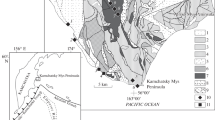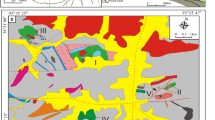Abstract
Both field relationships and geochemical characteristics indicate two suites of plagiogranitic and related rocks coexisting in the higher parts of the Karmoy ophiolite of western Norway. The plutonic zone of this ophiolite can be subdivided into three complexes; the East-Karmoy Igneous Complex, the Visnes High Level Complex and the Veavagen Igneous Complex and plagiogranitic rocks are well developed in the first two of these.
Within the East-Karmoy Igneous Complex, plagiogranites are associated with high temperature, pre-basic dyke, shear zones. Rare earth element modelling indicates that these plagiogranites were derived by anatexis of amphibolite (hydrated diabase) assuming a starting material consisting of 40% hornblende and 60% plagioclase and that batch melting occurred within the stability field of hornblende.
In comparison, plagiogranite occurs in a number of bodies in the upper part of the Visnes High Level Complex and forms a sandwich horizon together with biotite diorites and epidosites between a roof assemblage of dykes, microgabbros and magnetite gabbros, and a floor assemblage of layered and non-layered gabbros. The R.E.E. modelling of the petrogenesis of this series of plagiogranites indicates that they were derived by filter pressing of a differentiated interstitial liquid to the vari-textured gabbros, although the distribution of highly hygromagmatophile elements such as K, Rb, Ba, etc. cannot be explained satisfactorily by this model alone. Depletion in these elements appears to be an autometasomatic effect.
Similar content being viewed by others
References
Aldiss DT (1978) Granitic rocks of ophiolites. Ph.D. Thesis, Earth Sciences, the Open University, p 135
Allegre CJ, Minster JF (1978) Quantitative models of trace element behaviour in magmatic processes. Earth Planet Sci Lett 38:1–25
Arth JG, Barker F (1976) Rare-earth partitioning between hornblende and dacitic liquid and the implication for the genesis of trondhjemitic-tonalitic magmas. Geology 4:534–536
Arth JG, Barker F, Peterman ZE, Friedman I (1978) Geochemistry of the gabbro-diorite-tonalite-trondhjemite suite of southwest Finland and its implications for the origin of tonalitic and trondhjemitic magmas. J Petrol 19 2:289–316
Barker F (1979) Trondhjemite: Definition, environment, and hypothesis of origin. In: Barker F (ed) Trondhjemites, Dacites, and Related rocks. Elsevier, Amsterdam
Coleman RG, Peterman ZE (1975) Oceanic plagiogranite. J Geophys Res 80:1099–1108
Collerson KD, Fryer BJ (1978) The role of fluids in the formation and subsequent development of early continental crust. Contrib Mineral Petrol 67:151–167
Dixon S, Rutherford MJ (1979) Plagiogranites and late-stage immiscible liquids in ophiolite and mid-ocean ridge suites: An experimental study. Earth Planet Sci Lett 45:45–60
Eby GN (1980) Minor and trace element partitioning between immiscible ocelli-matrix pairs from lamprophyre dikes and sills, Monteregian Hills petrographic province, Quebec. Contrib Mineral Petrol 75:269–278
Flanagan FJ (1973) Values for international geochemical reference samples. Geochim Cosmochim Acta 41:361–367
Furnes H, Sturt BA, Griffin WL (1980) Trace element geochemistry of metabasalts from the Karmoy Ophiolite, southeast Norwegian Caledonides. Earth Planet Sci Lett 50:75–91
Heltz RT (1973) Phase relations of basalts in their melting range at P H2O=5 kb as a function of oxygen fugacity: part I. Mafic phases. J Petrol 14 2:249–302
Heltz RT (1976) Phase relations of basalts in their melting ranges at P H2O=5 kb part II. Melt compositions. J Petrol 17 2:139–193
Hess PC, Rutherford MJ (1974) Element fractionation between immiscible melts (abstr). Lunar Sci 5:328–330
Malpas J (1979) Two contrasting trodhjemite associations from transported ophiolites in western Newfoundland: Initial report. In: Barker F (ed) Trondhjemites, dacites, and related rocks. Elsevier, Amsterdam
Payne JG, Strong DF (1979) Origin of the Twillingate trondhjemite, north-central Newfoundland: Partial melting in the roots of an island arc. In: Barker F (ed) Trondhjemites, Dacites, and Related Rocks. Elsevier, Amsterdam
Pedersen RB (1982) The Karmoy ophiolite plutonic suite. Unpubl. Cand. Real. Thesis, University of Bergen
Philpotts AR (1982) Compositions of immiscible liquids in volcanic rocks, Contrib Mineral Petrol 80:201–218
Shaw DM (1970) Trace element fractionation during anatexis. Geochim Cosmochim Acta 34:237
Sturt BA, Thon A, Furnes H (1979) The Karmoy ophiolite, southwest Norway. Geology 7:316–320
Watson BE (1979) Zircon saturation in felsic liquids: Experimental results and application to trace element geochemistry. Contrib Mineral Petrol 70:407–419
Watson EB (1976) Two-liquid partition coefficients: experimental data and geochemical implications. Contrib Mineral Petrol 56:119–134
Wilson RAM (1959) The geology of the Xeros-Troodos area. Cyprus Geol Surv Dept Mem, No 1, p 135
Author information
Authors and Affiliations
Rights and permissions
About this article
Cite this article
Pedersen, R.B., Malpas, J. The origin of oceanic plagiogranites from the karmoy ophiolite, western Norway. Contr. Mineral. and Petrol. 88, 36–52 (1984). https://doi.org/10.1007/BF00371410
Accepted:
Issue Date:
DOI: https://doi.org/10.1007/BF00371410




